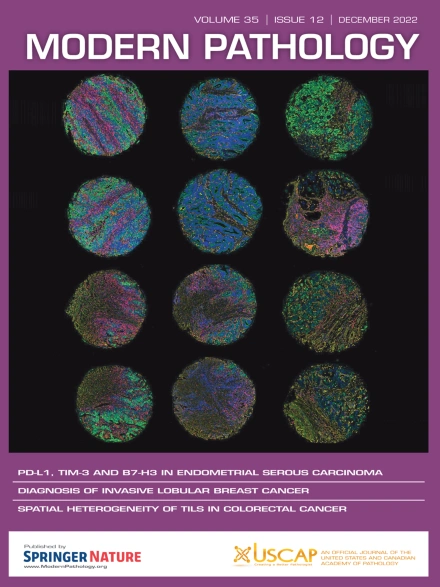Optimal Approaches to Grading Enteropancreatic Neuroendocrine Tumors Using Ki-67 Proliferation Index: Hotspot and Whole-Slide Digital Quantitative Analysis
IF 7.1
1区 医学
Q1 PATHOLOGY
引用次数: 0
Abstract
Grading neuroendocrine tumors using Ki-67 proliferation index (PI) is essential for prognostic assessment and therapeutic decision-making. However, the absence of standardized guidelines has led to methodological inconsistencies across pathology practices. This study aimed to establish more standardized approaches by evaluating grading methodologies and their impact on clinical outcomes using a large multisite data set. We analyzed 734 tissue sections from 325 patients, applying hotspot analysis (HSA) and whole-slide analysis (WSA) to determine Ki-67 PI and World Health Organization grade across primary tumors, regional metastases, and distant metastases. Ki-67 PI was quantified using digital image analysis, with WSA capturing the entire tumor proliferation profile and HSA focusing on the highest proliferating region. A patient-wise analysis was performed to determine the highest grade site per patient, and each case was assigned dual World Health Organization grades based on HSA and WSA. To evaluate the generalizability of our findings, we analyzed an external validation cohort of 74 patients, which was processed with independent image analysis software to ensure reproducibility. The analysis revealed that grading based solely on the primary tumor failed to predict clinical outcomes, as the highest grade site varied among the primary tumor (26.1%), regional metastases (39.1%), and distant metastases (34.8%). Within G2 tumors, survival outcomes differed significantly based on grading methodology, with diffuse G2 tumors (homogeneous Ki-67 distribution) demonstrating significantly worse survival compared with focal G2 tumors (84 vs 136 months; P < .01). Cox proportional hazards regression identified the maximum WSA Ki-67 PI as the sole independent predictor of overall survival, whereas TNM stage and tumor location (pancreatic vs jejunoileal) were not statistically significant. The external validation cohort reinforced these findings, confirming that diffuse G2 tumors exhibited significantly worse progression-free survival than focal G2 tumors. These findings emphasize the necessity of integrating both HSA and WSA for grading neuroendocrine tumors, as well as evaluating all available disease sites to ensure accurate prognostication. Incorporating digital image analysis into grading workflows can provide a more standardized, reproducible approach, improving clinical decision-making and patient outcomes.
利用Ki-67增殖指数对肠胰腺神经内分泌肿瘤进行分级的最佳方法:热点和全片数字定量分析
使用Ki-67增殖指数(PI)对神经内分泌肿瘤进行分级对预后评估和治疗决策至关重要。然而,标准化指南的缺乏导致了病理实践中方法的不一致。本研究旨在通过使用大型多站点数据集评估分级方法及其对临床结果的影响,建立更标准化的方法。我们分析了325例患者的734个组织切片,应用热点分析(HSA)和全切片分析(WSA)来确定原发性肿瘤、局部转移和远处转移的Ki-67 PI和世界卫生组织分级。使用数字图像分析对Ki-67 PI进行量化,其中WSA捕获整个肿瘤增殖谱,HSA聚焦于最高增殖区域。对患者进行分析以确定每个患者的最高分级部位,并根据HSA和WSA对每个病例进行双重世界卫生组织分级。为了评估我们发现的普遍性,我们分析了74名患者的外部验证队列,并使用独立的图像分析软件进行处理以确保可重复性。分析显示,单纯基于原发肿瘤的分级并不能预测临床结果,因为最高分级部位在原发肿瘤(26.1%)、局部转移(39.1%)和远处转移(34.8%)之间存在差异。在G2肿瘤中,基于分级方法的生存结果存在显著差异,弥漫性G2肿瘤(Ki-67均匀分布)与局灶性G2肿瘤相比显着更差(84个月vs 136个月;P & lt;. 01)。Cox比例风险回归发现最大WSA Ki-67 PI是总生存的唯一独立预测因子,而TNM分期和肿瘤位置(胰腺vs空肠回肠)无统计学意义。外部验证队列强化了这些发现,证实弥漫性G2肿瘤的无进展生存期明显低于局灶性G2肿瘤。这些发现强调了综合HSA和WSA对神经内分泌肿瘤分级的必要性,以及评估所有可用疾病部位以确保准确预后的必要性。将数字图像分析纳入分级工作流程可以提供更标准化、可重复的方法,改善临床决策和患者预后。
本文章由计算机程序翻译,如有差异,请以英文原文为准。
求助全文
约1分钟内获得全文
求助全文
来源期刊

Modern Pathology
医学-病理学
CiteScore
14.30
自引率
2.70%
发文量
174
审稿时长
18 days
期刊介绍:
Modern Pathology, an international journal under the ownership of The United States & Canadian Academy of Pathology (USCAP), serves as an authoritative platform for publishing top-tier clinical and translational research studies in pathology.
Original manuscripts are the primary focus of Modern Pathology, complemented by impactful editorials, reviews, and practice guidelines covering all facets of precision diagnostics in human pathology. The journal's scope includes advancements in molecular diagnostics and genomic classifications of diseases, breakthroughs in immune-oncology, computational science, applied bioinformatics, and digital pathology.
 求助内容:
求助内容: 应助结果提醒方式:
应助结果提醒方式:


